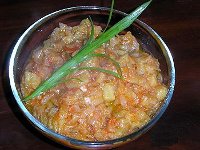Икра, часть вторая

Just because a can has the word икра on it does not necessarily mean that it contains caviar. If you chop vegetables finely, season them and mix them with some oil until they make a paste that resembles pressed caviar in texture, that is called икра, in which context it's probably best to translate it as pâté. One of the most common is баклажанная икра eggplant pâté (recipe), which is as ubiquitous in Russian families as California Dip is in American families. Кабачковая икра squash pâté is also common. I've even had грибная икра mushroom pâté in restaurants.
2 comments
you know sometimes we use the word синенький (diminutive form of синий = blue,but in this case it’s used as a noun) for eggplant. you can often hear it in south regions of Russia and in the Ukraine.
Don, have you ever heard Russians use the word “sinyak” (black and blue) for eggplant? It seems to me that they did in Stavropol’–maybe a regionalism or faulty memory on my part.
Don responds: That’s a new one on me, I’m afraid. Your question caused me to look up the word, and I was surprised to find a variety of meanings in addition to “bruise.” Among them were a type of mushroom that turns blue when cut/compressed; plants of the borage family; and a slang word for “alcoholic.” I did a few google searches with both синяк and баклажан as simultaneous keywords, but I found nothing that echoed the usage you suggest, although one site made me wonder if a dish made with eggplant might be called синяк. If we are fortunate, perhaps a native speaker who has encountered something similar will chime in.
Form is loading...